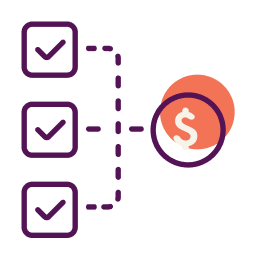Scroll financial headlines and you’ll likely see the term EBITDA mentioned more than once. Like this headline on Yahoo Finance: “Tap These 5 Bargain Stocks With Impressive EV-to-EBITDA Ratio”.
If you aren’t interested in financial analysis, you may wonder what that means to your small business. EBITDA doesn’t just measure the performance of a big business: small businesses can also benefit from knowing what this financial metric says about their business, too.
Why Small Businesses Should Know What EBITDA Means
EBITDA stands for Earnings Before Interest, Taxes, Depreciation, and Amortization. It’s a crucial concept for small businesses to understand. EBITDA serves two main purposes:
- Internal use: Business owners use EBITDA to measure their company’s profitability and track how it changes over time.
- External impact: Outside parties, such as lenders and investors, rely on EBITDA for various assessments.
Lending institutions often use EBITDA to:
- Estimate a company’s value for acquisition
- Assess a business’s ability to generate cash flow
- Compare different businesses in the same industry
Understanding EBITDA can help small business owners make better financial decisions and communicate more effectively with potential lenders or investors.
What Is EBITDA Margin
EBITDA margin shows the cash profit your business made for a given time period. It’s a useful tool to track your business’s cash profitability over time.
To calculate your company’s EBITDA margin:
- Use one of the EBITDA formulas (which we’ll cover later)
- Divide the result by total revenue
A good EBITDA margin is often 10% or higher, but this can vary based on:
- Your industry
- Company size
- Business goals
EBITDA and EBITDA margin calculations aren’t official GAAP (Generally Accepted Accounting Principles) metrics. However, many companies still report them. To gauge if your EBITDA margin is good, look at your competitors’ metrics as a starting point.
Keep in mind:
- EBITDA formulas aren’t regulated
- Public companies must show how they calculated EBITDA (SEC requirement)
- Private companies don’t have this requirement
If you’re comparing your EBITDA margin to non-public competitors, be cautious. Their calculation methods might differ from yours.
EBITDA Formula
Calculating EBITDA is straightforward if your financial statements are up to date. There are two main formulas you can use:
- Detailed Formula: EBITDA = Net Income + Interest + Taxes + Depreciation + Amortization Where:
- Net Income (E): Your business’s total earnings
- Interest (I): Interest expenses on borrowed money
- Taxes (T): Income tax expenses
- Depreciation (D): Cost of tangible assets spread over their useful life
- Amortization (A): Cost of intangible assets spread over their useful life
- You can find all these elements on your income statement.
- Simplified Formula: EBITDA = Operating Profit + Depreciation + Amortization Where:
- Operating Profit: Net profit with interest payments and taxes removed
- Depreciation and Amortization: Same as in the detailed formula
- Operating profit is also found on the income statement.
Both formulas give the same result. Choose the one that’s easier based on how your financial statements are organized.
Your cost of goods sold (COGS) tie into EBITA in a key way. COGS is the direct cost of producing the goods you sell or providing your services. EBITDA includes operating expenses and since COGS is an operating expense, it’s factored into your EBITDA calculation.
That also means that lower COGS means higher EBITDA. If you can reduce COGS without decreasing revenue, EBITDA will increase.
Remember:
- Keep your financial statements current for accurate EBITDA calculations
- Consistently use the same formula for meaningful comparisons over time
- EBITDA provides a view of your core operational profitability by excluding non-operational expenses
How To Calculate EBITDA
Calculating EBITDA is straightforward when your financial records are current. Here’s a step-by-step guide:
Gather your financial statements, especially your income statement.
Choose one of the EBITDA formulas we covered earlier:
- Detailed: EBITDA = Net Income + Interest + Taxes + Depreciation + Amortization
- Simplified: EBITDA = Operating Profit + Depreciation + Amortization
Use one of these tools to calculate your company’s EBITDA:
- Accounting software: Many programs allow you to create custom metrics. Check if yours has an EBITDA feature
- Spreadsheet software: Copy the needed data to Excel or Google Sheets. Create a simple formula using the EBITDA equation
- Manual calculation: Use a calculator if the other’s don’t work
Before you can calculate EBITDA, your bookkeeping needs to be up to date. Make sure you’re using a business bank account for all your revenue, and avoid commingling business and personal finances. (Business expenses should go on a business credit card, not a personal credit card.) If your accounting software is up to date, it should be easy to run these calculations.
Regularly update your EBITDA calculation, ideally monthly or quarterly. Then track your EBITDA over time to spot trends in your business’s performance.
To make it easier, be sure to:
- Keep your financial records up-to-date for accurate EBITDA figures
- Use the same calculation method consistently for meaningful comparisons
- Consider asking your accountant to help set up an EBITDA tracking system
By regularly calculating and monitoring your EBITDA, you’ll get insights into your company’s financial health, including operational efficiency and profitability.
What is Adjusted EBITDA?
Adjusted EBITDA is a modified version of regular EBITDA. It takes the standard EBITDA calculation and then adds or subtracts certain items to give what some consider a clearer picture of a company’s ongoing operational performance.
Common adjustments might include:
- One-time expenses: Like moving costs or fees from a lawsuit
- Non-cash expenses: Such as stock-based compensation
- Owner-specific expenses: For small businesses, this might be the owner’s salary if it’s not at market rate
- Startup costs: For new product lines or locations
- Restructuring costs: Expenses related to reorganizing the business
Why Is EBITDA Important
If you’re running a small business, you might wonder why EBITDA matters to you. Let’s break it down in simple terms.
EBITDA is like a snapshot of your business’s earning power. It shows how much money your business can make from its main activities, without worrying about things like taxes or how you’ve financed your business.
As a business owner, EBITDA can help you understand if your core business is profitable. It’s a way to see if you’re making money from what you actually do, rather than from clever accounting or one-time windfalls.
Banks and lenders like EBITDA too. When you apply for a loan, they might look at your EBITDA to guess if you’ll be able to pay them back. It gives them a quick way to size up your business’s health.
But EBITDA isn’t perfect, and there is some controversy around it. It doesn’t tell the whole story of your business. It leaves out some important costs, like when you need to buy new equipment or pay off loans. And because there’s no one “official” way to calculate it, some businesses might tweak the numbers to look better than they are.
So, while EBITDA can be useful, don’t rely on it alone. Use it alongside other measures (like cash flow and profitability) to get a full picture of how your business is doing.
Understanding basic financial concepts like EBITDA can help you make smarter decisions and talk more confidently with lenders or potential investors. Just keep it simple, be consistent in how you calculate it, and don’t be afraid to ask for help from an accountant if you need it.
What Is a Good EBITDA
When you calculate EBITDA, you might wonder, “Is my number good?” The truth is, there’s no one-size-fits-all answer. It’s a bit like asking, “What’s a good salary?”
It depends on a lot of factors.
EBITDA is usually shown in dollars (or your local currency), which can make it tricky to know if your number is good. A small local shop and a big tech company will have very different EBITDAs.
Here’s what affects your EBITDA:
- Your industry (some industries naturally have higher profit margins)
- The size of your business
- What stage your business is in (startup, growing, or well-established business)
Because EBITDA varies so much, many people prefer to use the EBITDA margin formula instead. It’s easier to compare because it’s shown as a percentage, not a dollar amount.
So, what’s a good EBITDA margin? Generally, 10% or higher is considered good. Think of it this way: if your EBITDA margin is 10%, it means you’re keeping 10 cents of every dollar you bring in, after accounting for your main operating expenses.
Remember, higher is usually better. A higher EBITDA margin means you’re keeping more of the money you’re bringing in. But don’t get too hung up on industry averages. What’s most important is that your EBITDA and EBITDA margin are improving over time.
The bottom line? While these numbers are useful, they’re just part of the picture. Use them as a guide, but also trust your gut and your detailed knowledge of your own business. And if you’re ever unsure, don’t hesitate to chat with an accountant or financial advisor who knows your industry.
EBITDA vs Revenue
Revenue is the income your business brings in before you pay expenses. Every dollar of revenue your business brings in by selling products or services is called “top line revenue”.
Revenue is calculated by multiplying the average price of sales/services by the number of sales. It is often found on the income sheet and is helpful when wanting to see how your business’s income has been growing over time.
EBITDA, on the other hand, looks at the income left over after accounting for expenses. We’ve shared several formulas for EBITDA above.
Nav’s Insight: What Does EBITDA Tell You
EBITDA gives you a snapshot of your business’s earning power. It’s like a quick health check for your company’s profitability.
If you’re thinking about getting a small business loan or selling your company in the next few years, lenders and potential buyers will likely ask about your EBITDA. By tracking it now, you’ll be prepared.
But remember, it’s just one measure of a company’s financial performance. Keeping track of your company’s earnings, expenses, debt and cash flow are also essential to running a financially successful business.
This article was originally written on September 20, 2024.




Have at it! We'd love to hear from you and encourage a lively discussion among our users. Please help us keep our site clean and protect yourself. Refrain from posting overtly promotional content, and avoid disclosing personal information such as bank account or phone numbers.
Reviews Disclosure: The responses below are not provided or commissioned by the credit card, financing and service companies that appear on this site. Responses have not been reviewed, approved or otherwise endorsed by the credit card, financing and service companies and it is not their responsibility to ensure all posts and/or questions are answered.